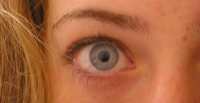|
What are eye migraines?
First, you need to remember that pain is only one possible symptom of migraine (see the article on symptoms). Other symptoms include nausea, congestion, and visual symptoms. Silent migraine or acephalgic migraine is migraine without the headache. Eye migraines – silent migraine:If this is you, you may be getting strange visual disturbances, usually lasting less than an hour, but no headache. You likely have a type of migraine, which needs to be treated in basically the same way as any other type of migraine. However, you do need to make sure you see a good doctor so that she can rule out other problems that can do permanent damage. Normally today silent migraine is referred to as migraine aura without headache. Eye migraines – Occular migraines:The term ocular migraine (sometimes spelled occular migriane) is another one that is no longer generally used. Most often in the past it has referred to retinal migraine, a rare type of migraine that has severe visual disturbances or blindness in one eye during an attack. Sometimes the term has also been used to describe other types of migraine that have visual auras, such as the much more common migraine with aura. Eye migraines - Ophthalmic migraine:Ophthalmic migraine ( also called opthalmic migraine) has the same symptoms as the occular migraines mentioned above, but occur at the height of the migraine, and most often occur in young men. Sometimes as time progresses the migraine sufferer will lose the headache and end up with a ophthalmic migraine which is a silent migraine (are you getting the hang of this now?). These are much more common eye migraines. The International Headache Society doesn't use this classification. That's why you may read a variety of descriptions with the same name. But many of these are now outdated. Eye migraines – ophthalmoplegic migraine:These have been called a rare type of migraine, though researchers now believe it's not technically a migraine at all. The headache is usually severe, and is accompanied by weakness in one or more of the eye muscles. Because of the decreased eye movement, you may experience temporary (less than 2 hours) double vision, drooping eyelid, or dilated pupil. Most often this problem is diagnosed in children. It is very important to have a thorough examination if you suspect you may have ophthalmoplegic migraine. Dr. Seymour Diamond writes in Conquering Your Migraine,"Double vision and muscle weakness may be caused by an aneurysm or it may have another organic origin...the individual should undergo a thorough examination and appropriate testing to rule out conditions other than ophthalmoplegic migraine." Eye migraines - Basilar migrainesBasilar migraines are not strictly just “eye migraines”, but the eye symptoms are often quite obvious and severe. These symptoms include a visual aura but also eye twitching, a graying out visually or even temporary partial blindness, vertigo, dizziness and more. This type of migraine is rare, but has some concerns of its own, so we have another article with all the details. Read here about basilar migraines and the unique problems that come with them. Sore eyes??If you're dealing with sore eyes, or pain around your eyes when you have a headache, consider getting an eye pillow. Eye pillows are also useful to block out the light. Read an overview of the flax seed eye pillow and IMAK eye pillow...
|
